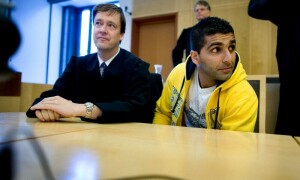The Jim Crow era of segregation, racist laws and the ‘separate but equal’ party line is well known for its mistreatment of African-Americans during the post-Civil War period in the United States. The term ‘Jim Crow’ embodied not only the derogatory terminology used as a caricature to describe blacks as lazy, shifty and good-for-nothing, but also the inherently racist laws that governed post-Civil War US. However, even though the constant violation of human rights equally affected women as well as men, the focus on the hardships that black women faced — not just at the hands of institutionalised racism, but also the patriarchy and misogyny that transcend racial lines — was swept under the rug while the oppression faced by black men made headlines.
Pauli Murray coined the term ‘Jane Crow’ to specifically address the twin oppressions of race and gender. Murray was born in 1910 in Maryland. Following the death of her parents, she was raised by her aunt, Pauline Fitzgerald Dame, in Durham, North Carolina, where she started experiencing the realities of being a black female in the American South. Murray had struggled all her life not just because she was black, but because she was a black woman. Her feelings of suppression were exacerbated by the fact that she firmly believed herself to be a heterosexual black man stuck in a black woman’s body. The convoluted race and gender politics that surrounded Murray’s identity caused her to come up with the phrase ‘Jane Crow’, a title which “conveyed economically the external threat Murray faced from race and gender discrimination, as well as the internal conflict she experienced from these intersecting oppressions.”
Even as a little girl, Murray felt that she was different: “‘queer’, ‘in between’, outwardly female but inwardly male — a ‘boy-girl’ in Aunt Pauline’s words.” Even though Aunt Pauline let the youngster foster her independent, tomboyish spirit, as she grew up, Murray started to realise that her childish tomboyishness was not going anywhere. She tried being a “normal” woman — she even got married to a man in an attempt to be like the other women around her. The marriage lasted a weekend. Everything about how she felt led Murray to believe that she might be a “pseudo-hermaphrodite.” Murray not only believed that she was a man trapped in a woman’s body, but also that she was a straight man. She was only attracted to feminine women. She imagined testosterone running through her veins, imagined male genitalia secreted away inside her, but numerous tests and exploratory surgeries revealed otherwise. Had she been born a few decades later, she would have been comfortable accepting her transgender identity. Be as it may, her “gender troubles ... inspired insights that were to change her life and the lives of others.”
A biography of one of the most accomplished and influential civil rights activists in the US sheds light on current racial and gender politics
Murray distinguished herself at school by working hard and receiving numerous accolades for her efforts. Despite the many curveballs thrown at her and the hurdles she had to face (including being denied admission to Harvard University because of her gender, and denied admission to the University of North Carolina because of her race), Murray persevered against all odds. She earned a master’s degree in law at the University of California, Berkeley, and in 1965 became the first African-American to receive a degree of Doctor of Juridical Science (JSD) from Yale Law School.
A very vocal civil rights activist since her youth, as a lawyer Murray started actively fighting civil rights and women’s rights cases. She became the first black deputy attorney general in California following the successful completion of her bar, and in 1950 published one of the most influential pieces of legal literature of her time, States’ Laws on Race and Colour. In this book she examined segregation laws in the US and commented on the intricate and pervasive nature of the racist legal system which, she argued, was unconstitutional. Her work inspired not one, but two future Supreme Court justices — Thurgood Marshall and Ruth Bader Ginsburg — who both recognise Murray as a monumental influence on the American civil rights movement.

Murray’s list of accomplishments did not end at her career as a lawyer fighting for the rights of the less fortunate. She taught at various universities, introducing concentrations such as Women’s Studies, African-American Studies and American Studies. If this weren’t enough, Murray, always a devout Christian, left academia in 1977 to join the Episcopal Church and become the first black woman to be ordained as an Episcopalian priest. She spent her remaining life working in a parish in Washington DC, mainly ministering to the sick and feeble. Reverend Dr Pauli Murray passed away in 1985 at the age of 74, having lived an inspiration-worthy life.
Rosalind Rosenberg has done a beautiful job chronicling Murray’s life within the pages of her book. The narrative tackles all aspects of Murray’s eventful life, including those that are still the topic of much controversy and discussion — even in 2018 — such as racial biases and gender politics. Rosenberg’s biography came out just as Yale University announced that it would be naming one of its two new colleges after its illustrious alumna, prompting much interest in this extremely important, yet oft overlooked individual.
Murray’s life deserves to be studied not just by history buffs, but anyone interested in understanding the grassroots of the current sociopolitical narrative surrounding racial and gender politics in the US. Rosenberg’s writing is clear and flows smooth, helping non-academic readers construct a coherent analysis of Murray’s incredible life and work. The book comes highly recommended by the reviewer.
The reviewer is a finance support specialist at Yale University
Jane Crow: The Life of Pauli Murray
By Rosalind Rosenberg
Oxford University Press, UK
ISBN: 978-0190656454
512pp.
Published in Dawn, Books & Authors, March 11th, 2018
















































Dear visitor, the comments section is undergoing an overhaul and will return soon.